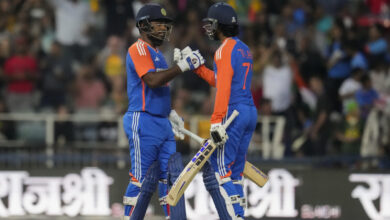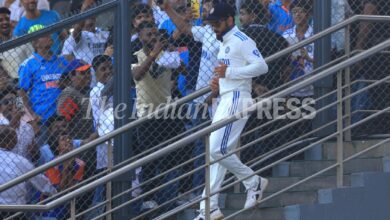Has Yuvraj Singh done enough to justify his selection in T20Is?

Over 16.2 of the English chase: Joe Root was struggling to get the big hits away, but with Ben Stokes at the other end, England were still in with a shout. Late dew impacted the bowlers, but Ashish Nehra realised the value of hitting the deck. Root improvised, and attempted a revere sweep. He found the man at short third man, Yuvraj Singh. The ball was hit straight at him, and yet the batsmen were able to crossover for a single.
The bowler gesticulated at the fielder, both of them oldies and still going in a format that leaves the ageing behind at a pace faster than light. Even so, it was an odd sight given how the bowler had been less than useful on the field himself. Nehra might as well have been a moving advertisement board as India defended 145. Yes, he was that poor, and yet his significant contribution with the ball to the team’s comeback win cannot be denied.
The other undeniable element about team India in these past two T20Is is the imbalance in the playing eleven. It is particularly seen in the selected batting order, especially with both Mandeep Singh and Rishabh Pant sitting out. Thus begs the question – what is the specific utility of the senior pros who are picked time and again even in a series-without-purpose as this one?
Well, Suresh Raina bowled four useful overs in the middle leg of England’s chase. From the get go, Virat Kohli was very clear how he would use him given there were two legspinners in the eleven and Parvez Rasool had been left out. Then, there is MS Dhoni, who is clearly still a force to reckon with behind the stumps and also chips in with his leadership qualities, as the new skipper gets accustomed to the hands-on limited-overs’ job.
Sure, Dhoni’s batting can use a kick-on given the lack of big hitting from India’s middle-order in these two games. But you cannot uproot experience in one go, irrespective of the stature of the series, or indeed the opposition. It underlines why Raina cannot be touched at the moment, and how Dhoni continues to be useful in this shortest format still. Thus the spotlight – awkwardly enough – rests squarely once again on Yuvraj.
Yes, this is the man who won India the World T20 in 2007. This is the man who won India the World Cup in 2011. The first tournament happened a decade ago, and the second one nearly six years prior. There is only so much past laurels can be bartered for, especially if there is a roadblock for the future generation, and it is certainly the case in this shortest format.
His ardent fans might take offense, citing his magnificent hundred in Cuttack. Yes, that can be additional leeway in this debate. However, it serves a timely reminder that Yuvraj’s selection in the ODI squad was a dubious inclusion in itself. MSK Prasad and his colleagues had gambled on someone who hadn’t played ODI cricket for three years. And it is only the benefit of hindsight after his hundred that allows them to claim ‘oh look, our move to recall him worked well’.
Let us go back to the basics here. His ODI selection was rooted in good Ranji form, especially 170-odd at Lahli and a follow-up double hundred in Delhi. As such, there is a reasoning why this worked in the 50-over set-up. That format still allows for time and ease of mind to build an innings, which was precisely the case in Cuttack. In that light, Yuvraj’s hundred was more relief than anything else that he scored in a dire situation.
If he hadn’t, given how Manish Pandey was unfairly discarded for this role after one bad series against New Zealand, there was no Plan B for the Indian team management ahead of the Champions Trophy as there are no more ODIs to be played until the summer. As such, it helped Dhoni settle down at No 5, and freed up Kedar Jadhav to do his thing at No 6. Effectively thus, it still remains a short-term solution keeping in mind India’s title defence in June.
Cynics will argue his case for T20s once again, but they will be quite wrong because the length of the format is quite crucial. India are missing enforcers in T20 cricket, hard hitters who can accelerate without blinking twice. Currently Yuvraj isn’t one of them, and unlike his First-Class to ODI return, statistics do not support his continued selection in the shortest format.
In 15 T20Is last year, from the Australian tour in January to the World T20 in March, Yuvraj averaged only 20.75 with a highest score of only 35. His lengthy run was down to the criterion he fulfilled for the middle-order/part allrounder role, but the key aspect herein though is his batting strike-rate. A figure of 104.40 at No 4 doesn’t do enough justice.
Look at Dhoni’s record during the same time. In the same interim, from Australia to the World T20, in 16 matches, the former Indian skipper averaged 55.66. Again, strike-rate is the underlining factor, and here Dhoni has a figure of 160.57 against his name.
In the 2016 IPL, their strike-rates are nearly similar – Dhoni’s 135.23 to Yuvraj’s 131.84. However, the IPL continuously throws up selection challenges when it comes to the international stage. For example, Raina has an undeniable record at No 3 in the IPL. But who can muster enough reason to make him bat ahead of Kohli in the T20Is? Sure, it is the norm currently as the Indian captain is opening the innings. But he admitted after the loss in Kanpur that it wouldn’t be the case ‘if Rohit Sharma was fit and available to open’.
Thus, it is critical to wonder aloud about Yuvraj’s utility in this shortest format. At a time when India is struggling due to a lack of big hits, his lack of form in the past two matches has only hampered the middle order’s ability to make an impact. Could it have been different with fresh blood infused, and a bit of experimentation in selection? Say, Mandeep opening, Kohli at No 3, Pandey/Pant at No 4 with Raina coming a bit later, enough to test the waters?
But it isn’t so. At best this T20I series is a lengthened international warm-up for the Champions Trophy, which explains Yuvraj’s continued presence in the T20I team.







